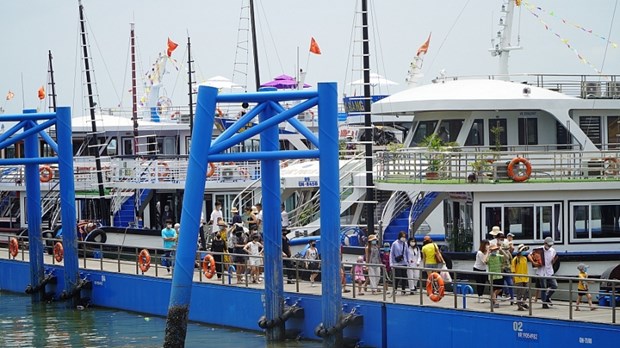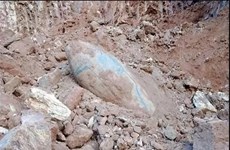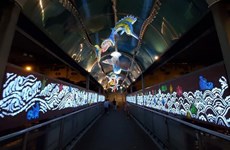Quang Ninh targets safe, attractive tourism destination
The northern province of Quang Ninh, home to UNESCO-recognised Ha Long Bay, is working hard to develop safe tourism products as the local tourism sector has been hit hard by the COVID-19 pandemic.
 In the first six months of this year, Quang Ninh attracted 2.5 million visitors, equivalent to 60 percent of the number recorded in the same period last year. (Photo: VNA)
In the first six months of this year, Quang Ninh attracted 2.5 million visitors, equivalent to 60 percent of the number recorded in the same period last year. (Photo: VNA)After containing the fourth wave of COVID-19 outbreaks, the locality has allowed travel facilities to restore their operation in line with pandemic prevention and control regulations.
Promotion tourism programmes have been launched at Ha Long Bay, the provincial museum and the Yen Tu relic and scenic complex, targeting local holiday-makers.
Local travel firms have joined hands to build chains of products and services to cut expenditures amidst difficulties caused by the pandemic, while stepping up the communication work.
The provincial tourism association has also proposed the provincial People’s Committee welcoming visitors with COVID-19 passes from other localities.
The tourism promotion agency under the provincial Department of Tourism has coordinated with the Heritage Travel Centre to draw up 25 tours in Quang Ninh, including border, maritime, ecological, community-based and spiritual tourism, all offering coronavirus testing services.
Chairwoman of the tourism association Nguyen Thi Bao said her association has proposed vaccinating tourism workers as soon as possible, saying with the full suite of services, Quang Ninh would serve not only domestic tourists but also foreigners in the new situation.
According to the local tourism department, in the first six months of this year, Quang Ninh attracted 2.5 million visitors, equivalent to 60 percent of the number recorded in the same period last year, earning 5.2 trillion VND (225.86 million USD) from the sector.
The province is striving to administer COVID-19 vaccines to 70-80 percent of local residents by April 2022 in order to reach herd immunity against.
According to head of the provincial Health Department Nguyen Trong Dien, to this end, the locality is speeding up COVID-19 vaccination campaign.
Recently, the province has administered tens of thousands of Sinopharm COVID-19 vaccine doses to workers in Chinese-invested firms in Quang Ninh and border residents, he said.
According to the provincial industrial parks management board, over 70 percent of workers in local IPs have been vaccinated against COVID-19 so far.
Within more than a week as of July 18, over 21,700 workers in IPs received the first shots.
Quang Ninh is now home to five IPs with around 30,500 workers.
In the fifth vaccination roll-out, the province gave priority to workers in Hai Ha Seaport IP in Hai Ha district, Hai Yen IP in Mong Cai city, Dong Mai IP in Quang Yen town and Viet Hung IP in Ha Long city.
So far, Quang Ninh has received about 260,000 COVID-19 vaccine doses of different kinds, with 60,000 doses administered. The province expects to inject the rest in July and August while waiting for more vaccine delivery.
The province hopes to become one of the first localities in Vietnam to reach herd immunity. It is planning to build a vaccination database and start the use of vaccine passport. The locality has also allocated personnel to deliver COVID-19 vaccines to locals in ethnic minority-inhabited, mountainous, islands and hard-to-reach areas.
By 2030, the province is set to welcome 3 million domestic visitors and 1.8 million foreigners, with revenue reaching 12.1 trillion VND.
Community-based tourism is expected to generate 4,200 jobs by 2025 and 9,500 by 2030.
Quang Ninh is endowed with natural advantages for sea and island tourism. It has a coastline of more than 250 kilometres and more than 2,000 islands and islets which account for two-thirds of the total number in Vietnam.
It is home to popular destinations such as Ha Long Bay, Bai Tu Long, Ha Long Bay National Park and some islands.
In particular, Ha Long Bay literally “descending dragon” bay, was twice recognised as a World Natural Heritage site by UNESCO in 1994 and 2000. The bay spans 1,553 square kilometres and includes 1,969 islands of various sizes. It features thousands of limestone karsts and islets in various shapes and sizes. The limestone in the bay has gone through 500 million years of formation in different conditions and environments. The geo-diversity of the environment has created biodiversity, including a tropical evergreen biosystem, oceanic and sea biosystem./.













